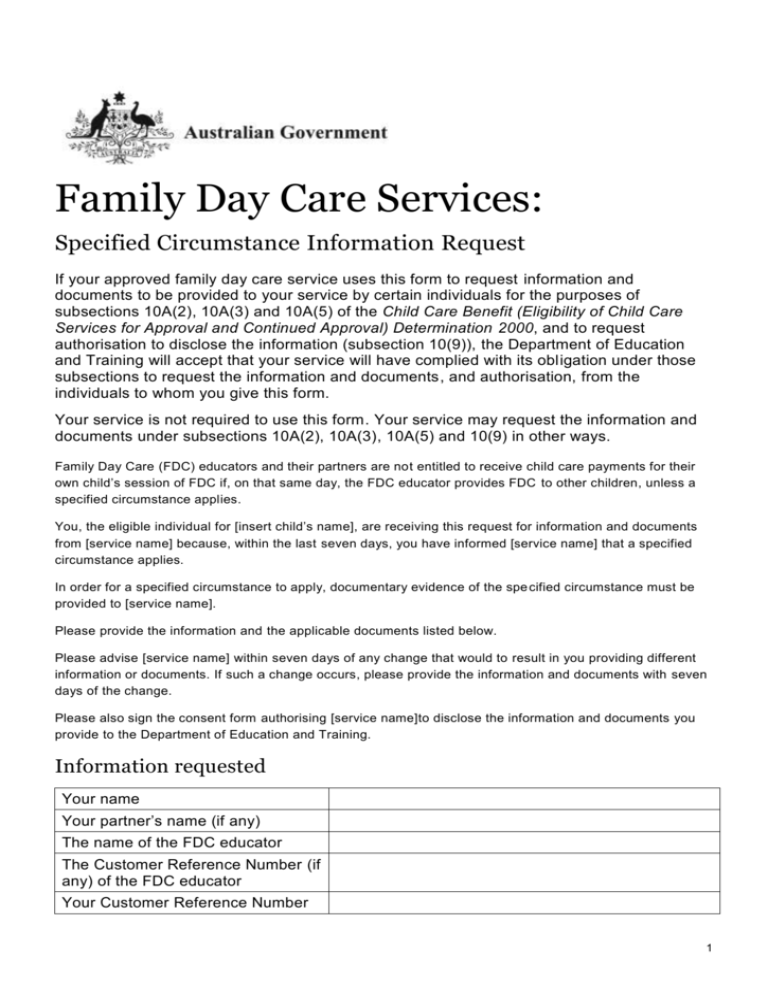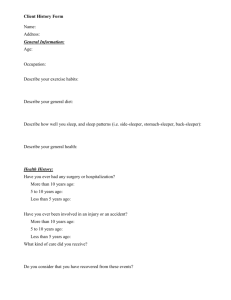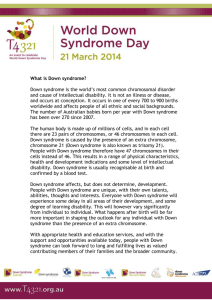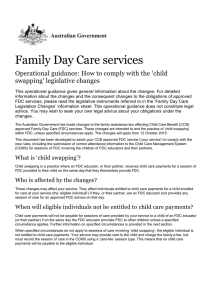Specified Circumstance Information Request
advertisement

Family Day Care Services: Specified Circumstance Information Request If your approved family day care service uses this form to request information and documents to be provided to your service by certain individuals for the purposes of subsections 10A(2), 10A(3) and 10A(5) of the Child Care Benefit (Eligibility of Child Care Services for Approval and Continued Approval) Determination 2000, and to request authorisation to disclose the information (subsection 10(9)), the Department of Education and Training will accept that your service will have complied with its obligation under those subsections to request the information and documents, and authorisation, from the individuals to whom you give this form. Your service is not required to use this form. Your service may request the information and documents under subsections 10A(2), 10A(3), 10A(5) and 10(9) in other ways. Family Day Care (FDC) educators and their partners are not entitled to receive child care payments for their own child’s session of FDC if, on that same day, the FDC educator provides FDC to other children, unless a specified circumstance applies. You, the eligible individual for [insert child’s name], are receiving this request for information and documents from [service name] because, within the last seven days, you have informed [service name] that a specified circumstance applies. In order for a specified circumstance to apply, documentary evidence of the spe cified circumstance must be provided to [service name]. Please provide the information and the applicable documents listed below. Please advise [service name] within seven days of any change that would to result in you providing different information or documents. If such a change occurs, please provide the information and documents with seven days of the change. Please also sign the consent form authorising [service name]to disclose the information and documents you provide to the Department of Education and Training. Information requested Your name Your partner’s name (if any) The name of the FDC educator The Customer Reference Number (if any) of the FDC educator Your Customer Reference Number 1 (if any), if you are not the FDC educator The Centrelink Customer Reference Number of the child The name/s of the FDC service/s where the FDC educator works The days and start and end times of the sessions of care when the FDC educator ordinarily works for an FDC service as an FDC educator. 2 Documents requested Evidence that the child is an Eligible disability child (delete if not applicable) If your child has been diagnosed with a disability, provide documentary evidence to [service name] that: Either: your child has been diagnosed by a qualified medical practitioner as suffering from one or more of the conditions listed in Attachment A; or your child has been diagnosed by a registered psychologist as suffering from one or more of the conditions listed in Attachment B, and the diagnosis was made no more than 24 months before you provide this documentary evidence to [service name]. Evidence that the child is a Remote area child (delete if not applicable) If your child resides in a location that is designated as ‘remote’ or ‘very remote’ Australia – provide documentary evidence to [service name] of where your child resides. that the child lives in ‘remote’ or ‘very remote’ Australia. Documentary evidence of a child’s residence could include a copy of your current driver’s licence (if the child lives at the same address as you), or a recent utility bill sent to the address where the child resides, or a statutory declaration. It is up to [service name] to determine whether your child is a ‘remote area child’. All you have to do is provide evidence of where your child resides to [service name]. If you wish to work out whether your child resides in ‘remote’ or ‘very remote’ Australia: you can use the ABS Remoteness Structure Maps which are located on the Australian Bureau of Statistics website, at: http://www.abs.gov.au/AUSSTATS/abs@.nsf/DetailsPage/1270.0.55.005July%202011?OpenDocumen t; or if you can’t work it out from this, you may find it helpful to use the DoctorConnect website, at: http://www.doctorconnect.gov.au/internet/otd/publishing.nsf/Content/MMM_locator. If using this tool, areas that are classified as ‘remote’ are identified as ‘MMM 6’ and ‘very remote’ is identified as ‘MMM 7’. Please note that if there is any discrepancy in the results obtained by using the two tools, the Remoteness Structure Maps on the ABS website is the one that determines whether a child is a ‘remote area child ’ for the purposes of the family assistance law. Evidence for FDC educator required to undertake paid work not for an FDC service (delete if not applicable) You may be eligible to receive child care payments for your child on a day that you or your partner works as an FDC educator if the FDC educator: is required to work for at least two hours on the same day their child is in care with [service name], and the work is paid work which is not for an approved FDC service, and documentary evidence has been provided to [service name], showing that the FDC educator is usually required to work on the same day and time the session of care is provided by [service name] to your child. Evidence may include a letter from an employer, a contract of employment, a payslip, or another type of document that clearly shows the person usually works at the time [service name] provides care to the child. This work must not be for an approved FDC service. 3 Evidence for education or training (delete if not applicable) You may be eligible to receive child care payments for your child on a day that you or your partner works as an FDC educator if the FDC educator: is enrolled in a programme or course of education or training towards a recognised qualification (at Certificate III level or above) provided by a Registered Training Organisation, and is engaged in activities for the purposes of the programme or course on the care day (i.e. attends the training institution for the purposes of the programme or course), and you have provided [service name] with documentary evidence that the FDC educator usually studies at the time the session of care is provided by [service name] to your child. Evidence for this specified circumstance could include a proof of enrolment letter from the Registered Training Organisation, copy of an enrolment form and programme/course participation records. Please note – if your child is an ‘eligible ISS child’ you are not required to provide any documentary evidence to [service name]. If you are not sure whether your child is an ‘eligible ISS child’, please discuss this with us. 4 Authorisation to disclose information and documents to the Department of Education and Training Note: [service name] is required under subsection 10A(9) of the Child Care Benefit (Eligibility of Child Care Services for Approval and Continued Approval) Determination 2000 to request your authorisation to disclose the information and documents provided pursuant to this form to the Secretary of the Department of Education and Training. If you agree, please complete this authorisation: I, (name) ___________________________________________________, give my consent for the information I have provided to be disclosed to the Secretary of the Department of Education and Training. Signed: Date: ___________________________________________________ ___________________________________________________ 5 Attachment A (delete if not applicable) (a) (b) (c) (d) (e) (f) (g) (h) (i) (j) (k) (l) (m) (n) (o) (p) (q) (r) (s) (t) (u) Moderate to severe multiple disability or moderate to severe physical disability (including neurological disability) where the child is, or is likely to be, dependent for mobility indoors and outdoors from 3 years of age onwards. Severe multiple or physical disability (including uncontrolled seizures), requiring constant care and attention where the child is less than 6 months of age. Moderate, severe or profound intellectual disability where IQ is less than 55. This includes a child with a known syndrome. Autism Spectrum Disorder when diagnosed by a psychiatrist or developmental paediatrician experienced in the assessment of Pervasive Developmental Disorders and using the fifth edition of the Diagnositic and Statistical Manual of Mental Disorders (DSM-5). Autistic Disorder or Asperger's Disorder (not including Pervasive Developmental Disorder not otherwise specified) when diagnosed by a psychiatrist or developmental paediatrician experienced in the assessment of Pervasive Development Disorders and using the fourth e dition of the Diagnostic and Statistical Manual of Mental Disorders (DSM-IV). Childhood Disintegrative Disorder diagnosed by a psychiatrist using DSM -IV. Major depression of childhood diagnosed by a psychiatrist using DSM -IV or DSM-5. Childhood schizophrenia diagnosed by a psychiatrist using DSM-IV or DSM-5. Bilateral blindness where: (i) visual acuity is less than or equal to 6/60 with corrected vision, or (ii) visual fields are reduced to a measured arc of less than 10 degrees. A 45 decibels or more hearing loss in the better ear, based on a 4 frequency pure tone average (using 500, 1,000, 2,000 and 4,000Hz). Deaf-blindness diagnosed by a specialist multidisciplinary team, including a professional audiological and ophthalmological evaluation. Epilepsy (uncontrolled while on medication). Cystic Fibrosis. Down syndrome. Fragile X syndrome. Diabetes Mellitus Type 1. Phenylketonuria (PKU). Other inborn errors of metabolism (not specified elsewhere) that are treated by medically prescribed diet to prevent neurological disability and/or severe organ damage. Example: Organic acidaemias, urea cycle defects, galactosaemia and some fatty acid or oxidation defects. Moderate to severe Osteogenisis Imperfecta with 2 or more fractures per year and/or significant pain that significantly limits activities of daily living. Chromosomal or syndromic conditions (not specified elsewhere) where there is moderate or severe intellectual disability and/or multiple, major and permanent physical abnormalities as diagnosed by a paediatrician, paediatric sub-specialist or clinical geneticist. Example: Children with a moderate or severe intellectual disability and/or multiple, major and permanent physical abnormalities who have been diagnosed with Cri du chat syndrome, Rett syndrome, Angelman syndrome, Prader-Willi syndrome, Edwards syndrome (Trisomy 18), Williams syndrome, Patau syndrome (Trisomy 13), Coffin-Lowry syndrome, Congenital rubella syndrome, Cornelia de Lange syndrome, Kabuki Make-up syndrome, Larsen syndrome, Opitz G syndrome, Pallister-Killian syndrome, Seckel syndrome, Smith-Magenis syndrome, CHARGE association. Note: This category may apply to children diagnosed with other non-listed chromosomal or syndromic conditions who have a moderate or severe level of intellectual disability and/or multiple, major and permanent physical abnormalities. Neurometabolic degenerative conditions where there is moderate or severe intellectual and/or moderate or severe physical disability as diagnosed by a paediatrician, paediatric sub-specialist or clinical geneticist: (i) Lysosomal storage disorders. 6 (v) (w) (x) (y) Example: Children with a moderate or severe intellectual and/or physical disability who have been diagnosed with metachromatic Leukodystrophy, Tay Sachs disease, Krabbe disease, Pompe's disease, Mucopolysaccharidoses (Hurler syndrome (MPS 1), Hunter syndrome (MPS 2), San Filipo syndrome (MPS 3), Morquio syndrome (MPS IVA), Maroteaux-Lamy syndrome (MPS VI)). Neurometabolic conditions. Example: Children with a moderate or severe intellectual and/or physical disability who have been diagnosed with Lesch Nyhan syndrome, Menkes disease, Zellweger syndrome and related peroxisomal disorders, some mitochondrial respiratory chain disorders. Note: This category may apply to children diagnosed with other non-listed neurometabolic degenerative conditions who have a moderate or severe level of intellectual and/or physical disability. Neurodegenerative disorders where there is moderate or severe intellectual and/or moderate or severe physical disability as diagnosed by a paediatrician, paediatric sub -specialist or clinical geneticist. Example: Children with a moderate or severe intellectual and/or physical disability who have been diagnosed with Ataxia Telangiectasia, unclassified Leukodystrophies. Note: This category may apply to children diagnosed with other non-listed neurodegenerative conditions who have a moderate or severe level of intellectual and/or physical disability. The following dermatological conditions: (i) Epidermolysis Bullosa Dystrophica; (ii) Hypohidrotic ectodermal dysplasia (synonym: anhidrotic ectodermal dysplasia); (iii) Hay Wells syndrome (synonym: ankylobepharon, ectodermal dysplasia and clefting (AEC) syndrome); (iv) Lamellar ichthyosis; (v) Harlequin ichthyosis; (vi) Sjorgren Larsson syndrome; (vii) Netherton syndrome; (viii) Severe congenital ichthyosiform erythroderma; (ix) Generalised bullous ichthyosis (synonym: bullous ichthyosiform eryt hroderma; epidermolytic hyperkeratosis). Any of the following neuromuscular conditions: (i) Duchenne (or Becker) muscular dystrophy; (ii) Autosomal recessive muscular dystrophy; (iii) Spinal muscular atrophy conditions, for example Werdnig-Hoffman; (iv) Friedrich's Ataxia. 7 Attachment B (delete if not applicable) (a) (b) (c) Autism Spectrum Disorder when diagnosed by a registered psychologist experienced in the assessment of Pervasive Developmental Disorders and using the fifth edition of the Diagnositic and Statistical Manual of Mental Disorders (DSM-5). Autistic Disorder or Asperger's Disorder (not including Pervasive Developmental Disorder not otherwise specified) when diagnosed by a registered psychologist experienced in the assessment of Pervasive Development Disorders and using the fourth edition of the Diagnostic and Statistical Manual of Mental Disorders (DSM-IV). Moderate, severe or profound intellectual disability where IQ is less than 55. This includes a child with a known syndrome. 8







